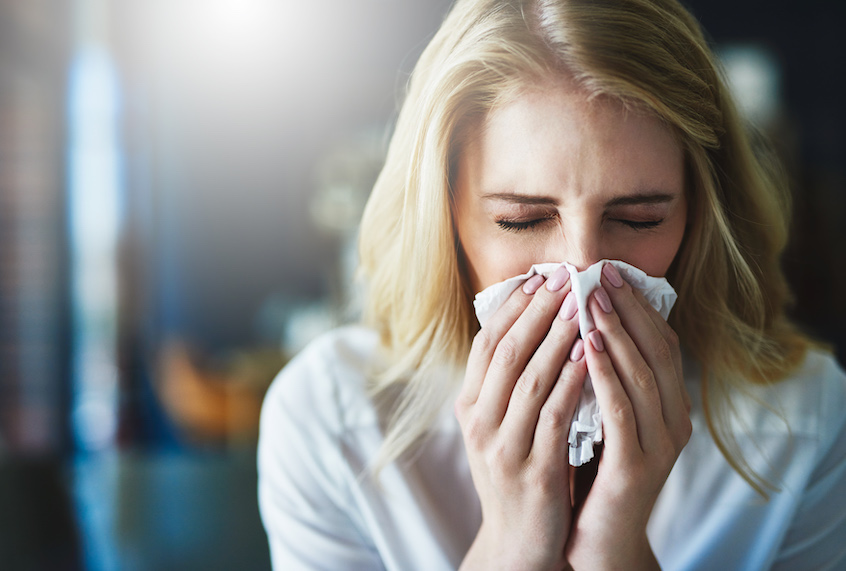In 1934, Williams Wells was the first scientist to convincingly describe airborne transmission of disease. He identified two main ways pathogens spread: large droplets, which fall due to gravity, and small droplets, which waft through the air as they evaporate. Pathogens like Ebola can be transmitted through large droplets, where diseases like measles spread through small ones.
It may surprise you that for more than 80 years — despite new diseases, new means of travel, and new technology — our understanding of these basic routes haven’t changed much. Not until recently, when Lydia Bourouiba, assistant professor of civil and environmental engineering and director of the Fluid Dynamics of Disease Transmission Laboratory, began to redefine how we think about disease transmission — literally from the ground up.
Bourouiba began her career by studying the mathematics of how fluids flow, specifically looking at liquids with turbulent or chaotic flows. When she moved to Toronto shortly after the SARS epidemic, she realized that similar mathematical principles could be useful in modeling how diseases spread. That’s when she began to use math to improve epidemiology. “I started seeing these gaps in understanding transmission, and [seeing] that fluid dynamics could help,” explains Bourouiba.
Traditionally, scientists have created epidemiological models by developing equations, based on a variety of parameters that describe how diseases are transmitted between people and populations. However, many of these parameters are not based on physical principles — like how sneezing actually transmits disease, or what factors influence how far sneeze droplets may travel.
Bourouiba thinks that improving the accuracy of these parameters can greatly improve the models. “If you don’t have a mechanism to bring [the parameters] down to something we can measure, you end up fitting data to these models,” says Bourouiba, rather than designing models that incorporate real-world physics. “You lose the predictability power.”
So Bourouiba moved to MIT as a postdoctoral fellow, and began to try to explain how diseases are transmitted globally based on how they are transmitted between you and your neighbor. Equipped with high-speed cameras, sophisticated models, and groups of patients, Bourouiba and her team are now answering fundamental questions about the mechanisms of disease transmission.
Many of these questions already have answers, like how long the ejection of sneezing lasts, where large droplets land, or how small droplets can travel around a room. But Bourouiba is now bringing biology into the mix. During TEDMED, her team released new work showing how droplets containing bacteria can last up to ten times longer than droplets not laden with bacteria. Even worse, at faster speeds, these droplets can split into ten times more droplets.
The next step is understanding how a sneeze can transmit viruses in the context of models that could impact the next year’s flu season. Her broad findings have already identified suggestions for disease control that can be implemented, influencing a variety of public health protocols and policies.
But she still has further questions — like how the size of droplets can impact our susceptibility to disease. “The properties that [the droplets] have initially can influence how far down they can get in the lungs,” says Bourouiba. “If we can understand the whole process, we could then determine — at the source — who would have better ability to transmit the disease effectively.”
This could inform how we manage numerous pathogens. Take tuberculosis, a disease that infects up to a third of the world’s population. Researchers know its symptoms begin deep in the lungs, but further characterization of when, how, and why people produce infectious droplets could improve how we handle patient care and research.
Bourouiba is excited about a multi-year study she’s working on in collaboration with physicians in Boston, studying flu patients to characterize transmission dynamics. Pioneering work in this interdisciplinary field isn’t easy. But Bourouiba says that ten to twenty years of this kind of research could lead to dramatic, tangible results, useful for a variety of pathogens. Considering the long and often uncertain process of developing new vaccines and diagnostics for infectious diseases, her approach to defining evidence-based prevention strategies is a vital piece of the puzzle. “You have to be doing both [prevention and treatment research].” It’s also becoming ever more important. Because of rising antibiotic resistance, she explains, “We might be going into an era [similiar] to pre-antibiotic times, which is extremely concerning.”
Bourouiba’s work is an important step toward redefining disease transmission, from descriptions to mechanisms. Truly understanding how people get each other sick will help us design protocols, policies, and tools to help people stay healthy.

